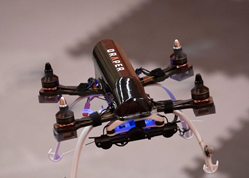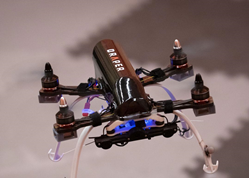
Draper is on a team headed by Rutgers University to extend the flying range of small unmanned aerial vehicles (sUAVs). Credit: Draper
“A battery that doubles or triples the energy density while meeting all other necessary performance requirements is well beyond the current performance of commercial solutions, but is within reach of the developer community,” Rob Doe, an energy storage expert and microsystems integrator at Draper.
CAMBRIDGE, Mass. (PRWEB)
March 22, 2022
Sensors and small aerial drones are touted as force multipliers for the military. Drones, known to specialists as unmanned aerial vehicles (UAVs), serve as the eyes and ears for combat and surveillance operations while keeping soldiers and intelligence personnel out of harm’s way.
UAVs can be configured to detect weapons, track troop movements and even pick up trace amounts of chemicals. But a key component that has long stymied UAVs is an adequate power source: aerial drones typically cannot fly for as long or as well in demanding operational conditions as many missions require.
Now scientists and engineers are developing a power source for UAVs that can better withstand conditions such as large temperature fluctuations, vibration and shock. The new tech incorporates recent advances in electrochemistry, microelectronics and packaging that combine for novel energy storage. The aim is to create reliable power solutions for missions conducted in extreme and challenging environments—and potentially triple battery life over best-in-class lithium-ion.
Rob Doe, an energy storage expert and microsystems integrator at Draper, says improving a drone’s power supply, or battery, is possible given recent advances in science and technology. “A battery that doubles or triples the energy density while meeting all other necessary performance requirements is well beyond the current performance of commercial solutions, but is within reach of the developer community,” Doe said.
Doe and his colleagues at Draper are contributing to the development of sensors and UAVs as part of a team recently selected by the Intelligence Advanced Research Projects Activity (IARPA). Led by Rutgers University, the team is developing portable power solutions for IARPA’s Robust Energy Sources for Intelligence Logistics In Extreme, Novel and Challenging Environments (RESILIENCE) program.
Battery cell development, using rechargeable lithium metal, is headed by Glenn Amatucci, Ph.D., professor of materials science engineering and director of the Energy Storage Research Group at the Rutgers School of Engineering. Draper’s primary contribution is to leverage its expertise in custom microelectronics, packaging and systems integration to optimize the energy storage system output, meet stringent size requirements and accelerate adoption of Rutgers’ energy storage solution.
The team has set a goal of developing a power source for drones, small sensors and portable devices that exceeds that of rechargeable lithium-ion batteries and single-use legacy lithium batteries. The team is working to create new electrochemical energy storage solutions, and lay the foundation for using rechargeable lithium metal in the power source they create. The vision is to extend battery life and design a battery that can be charged and discharged thousands of times.
IARPA says the aim of the RESILIENCE program is to develop “portable power solutions for electronics that can operate under the demanding operational conditions experienced by intelligence community officers.” If successful, the effort will provide power sources to extend the function of unmanned aerial vehicles (UAVs) with vertical takeoff and landing capability and unattended electronic devices, which must operate in extreme environmental conditions for years.
The company has previously applied its multidisciplinary engineering capabilities to a variety of related programs including to tiny, robust communications and navigation devices; persistent surveillance systems; and navigation software for drones.
This publication was supported by a subaward from Rutgers, the State University of New Jersey, under Award No. 2021-21060200003 from the Office of the Director of National Intelligence – IARPA.
Any opinions, findings, and conclusions or recommendations expressed in this publication are those of the author(s) and do not necessarily reflect the views of Rutgers or those of the Office of Director of National Intelligence – IARPA.
Draper
At Draper, we believe exciting things happen when new capabilities are imagined and created. Whether formulating a concept and developing each component to achieve a field-ready prototype or combining existing technologies in new ways, Draper engineers apply multidisciplinary approaches that deliver new capabilities to customers. As a nonprofit engineering innovation company, Draper focuses on the design, development and deployment of advanced technological solutions for the world’s most challenging and important problems. We provide engineering solutions directly to government, industry and academia; work on teams as prime contractor or subcontractor; and participate as a collaborator in consortia. We provide unbiased assessments of technology or systems designed or recommended by other organizations—custom designed, as well as commercial-off-the-shelf. http://www.draper.com
Share article on social media or email:

